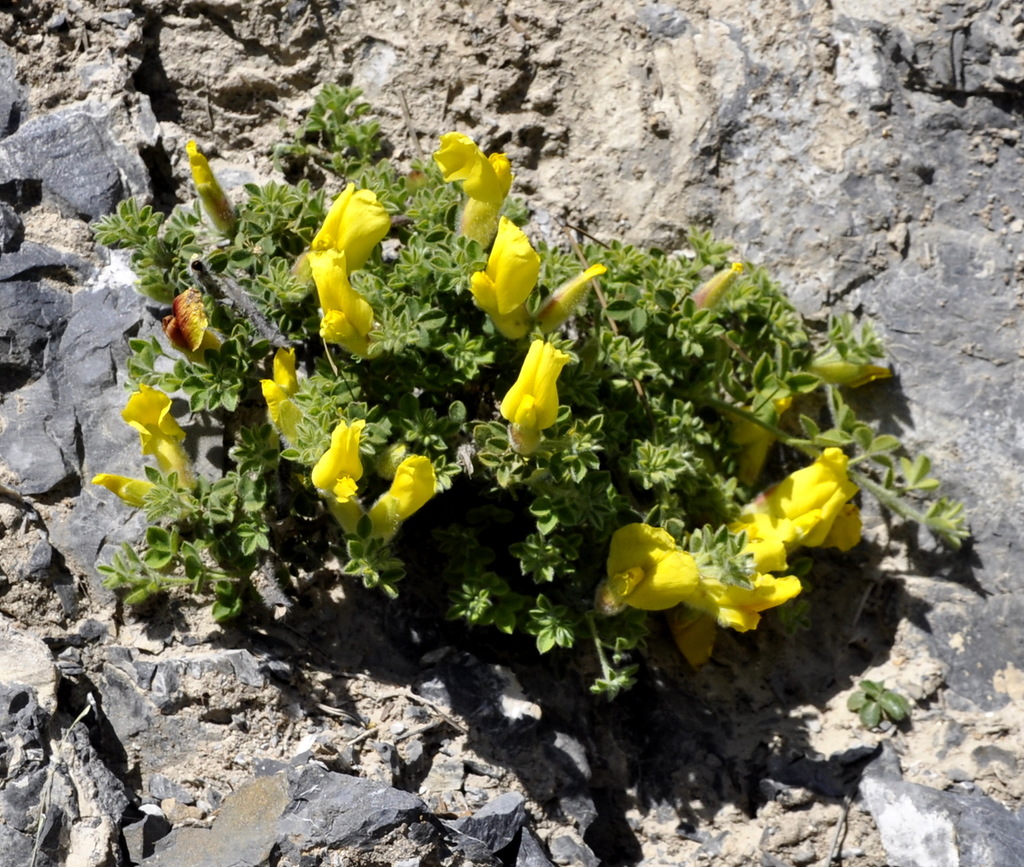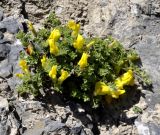
Цветущее растение. Греция, Пиерия, Олимп, ок. 800 м н.у.м. 22.03.2014.
See also:
Discussion (4)
All photos of taxon (21)
Code of link to photo
| Create: | HTML or BBCode with preview |
| Code for linking on the web: | |
| This is how it will look: |  Chamaecytisus polytrichus on the site «Plantarium» |
Text to cite the page
Цандекидис Р. 2014. Изображение Chamaecytisus polytrichus (M. Bieb.) Rothm. // Плантариум. Растения и лишайники России и сопредельных стран: открытый онлайн атлас и определитель растений. [Электронный ресурс] URL: https://www.plantarium.ru/page/image/id/229411.html (дата обращения: 21.03.2025).
Tsantekidis R. 2014. Image of Chamaecytisus polytrichus (M. Bieb.) Rothm. // Plantarium. Plants and lichens of Russia and neighboring countries: open online galleries and plant identification guide. URL: https://www.plantarium.ru/lang/en/page/image/id/229411.html (accessed on 21 Mar 2025).
Views: 4854Discussion
| Roland Tsantekidis | Chamaecytisus austriacus? |
| Andriy Kovalchuk | Роланд, пожалуйста, указывайте для всех горных снимков примерную высоту над уровнем моря. |
| Timur Bulgakov | Маловат для австрийского. |
| Roland Tsantekidis | Это описание растения мне прислали местные ботаники. Я в этом ничего не понимаю, но может быть кому-нибудь из "Плантариума" это пригодится 
Kαλημερα!!! 2. Chamaecytisus LINK A. STRID Unarmed shrubs, differing from Cytisus in the always 3-foliolate leaves and the tubular, bilabiate calyx, the upper lip with 2 short teeth and the lower with 3 short t e e t h . -A taxonomically difficult genus of possibly 30 species, chiefly in SE Europe. Hair characters, which have been used extensively to distinguish species, are extremely variable even within populations, and far too many taxa have been recognized especially from Bulgaria. 1. Flowers in leafy racemes 2. - Flowers in distinct terminal heads 3. 2. Ascending to erect, up to 80 m. Legume usually hairy only on the edges 1. Ch. hirsutus - Procumbent, with branches up to 30 cm. Legume patent-villous all round 2. Ch. polytrichus 3. Corolla white. Legume less than 15 mm 5. Ch. albus - Corolla yellow. Legume more than 18 mm 4. 4. Leaflets 8-16 mm, densely appressed-sericeous and ± silvery on both sides 3. Ch. eriocarpus - Leaflets usually larger, subglabrous to sparsely appressed-pubescent above, ± green on both sides 4. Ch. austriacus 1. Ch. hirsutus (L.) LINK, Handb. 2: 155 (1831) Basionym: Cytisus hirsutus L., Sp. PL: 739 (1753). "Habitat in Hispania, Sibiria, Austria, Italia". Syn.: Cytisus falcatus WALDST. & KIT., PL Rar. Hung. 3: 264 t. 238 (1807); Cytisus hirsutus var. falcatus (WALDST. & KIT.) HALACSY, Consp. Fl. Gr. 1: 337 (1900); Cytisus ciliatus WAHLENB., Fl. Carp.: 219 (1814); Cytisus hirsutus ssp. 2. Chamaecytisus 449 ciliatus (WAHLENB.) BRIQ., Cytises Alp. Marit.: 169 (1894); Chamaecytisus ciliatus (WAHLENB.) ROTHM. in Feddes Repert. Spec. Nov. Regni Veg. 53: 144 (1944); Cytisus hirsutissimus C. KOCH in Linnaea 19: 62 (1847); Cytisus hirsutus var. hirsutissimus (C. KOCH) BOISS., Fl. Or. 2: 51 (1872); Cytisus leucotrichus SCHUR in Oesterr. Bot. Z. 10: 179 (1860); Cytisus hirsutus ssp. leucotrichus (SCHUR) ASCHERSON & GRAEBNER, Syn. Mitteleur. Fl. 6, 2: 317 (1907). Resembling Ch. polytrichus (no. 2), but a larger shrub up to 80 cm tall, with ascending to erect, ± straight branches. Leaflets varying considerably in size and pubescence, but generally larger than in Ch. polytrichus and sparsely pubescent to glabrescent above. Legume hairy only on the margins or sparsely hairy all round in the distal part. Chiefly a species of open woodland and scrub between c. 400 and 1500 m, occasionally up to 2200 m in rocky places, on a variety of substrates. Flowering from mid-April to the beginning of July according to the altitude. PELOPONNISOS: Parnon!, Killini (HALACSY 1900:337); STEREA ELLAS: Vardousia!; S PINDHOS: In valle Negerli prope Chaliki!, Near the monastery of Korona (HALACSY loc. cit.); N PINDHOS: Near village Milea!, Smolikas!; NORTH CENTRAL: Varnous!, Vourinos!; Kajmakcalan!, NE of Fiorina!, Between Pisodherion and Fiorina!; NORTH EAST: Near Soufli!, Between Lekhani and Kechrokampos!, Forest Elatia in Rodhopi! A very variable species, widespread in C and S Europe and in Anatolia. Ch. ciliatus (WAHLENB.) ROTHM. , which was retained as a separate species in both Fl. Eur. 2: 91 (1968) and in Fl. Bulg. 6: 82 (1976), is scarcely distinct from Ch. hirsutus, although it tends to have larger leaflets and be less hairy on all parts. It seems more properly treated as Ch. hirsutus (L.) LINK ssp. ciliatus (WAHLENB.) STRID, comb, nova (basionym, see above). Variation in leaf and fruit characters is poorly correlated, at least in Greek material. Densely hairy plants from high altitudes (1800-2200 m) on Varnous and Kajmakcalan tend to have flowers aggregated towards the tips of branches, and approach forms of Ch. supinus (L.) LINK; they may represent hybrid populations or another subspecies of Ch. hirsutus. Several chromosome numbers have been reported: 2n=c. 46 and 48 (CASTRO 1949: 87, garden material of Ch. hirsutus s.l.); 2n=50 in Ch. ciliatus from Austria (FORISSIER in Taxon 22: 647, 1973) and Bulgaria (KUZMANOV & GEORGIEVA in Taxon 26: 448, 1977), and in Ch. hirsutus from Bulgaria (KUZMANOV & MARKOVA in Taxon 22: 288, 1973); 2n=96 in Ch. ciliatus from Bulgaria (KUZMANOV & MARKOVA loc. cit.), and in Ch. hirsutus s.str. from Bulgaria (KUZMANOV & al. in Taxon 22: 461, 1973); n=50 in Ch. hirsutus from the Alps (FORISSIER 1973: 53). 2. Ch. polytrichus (BIEB.) ROTHM. in Feddes Repert. Spec. Nov. Regn. Veg. 53: 144 (1944) Basionym: Cytisus polytrichus BIEB., Fl. Taur.-Cauc. 3: 477 (1819), described from the Crimea. 450 FABACEAE Syn.: Cytisus hirsutus L. ssp. hirsutus var. polytrichus (BIEB.) BRIQ., Cytises Alp. Marit.: 171 (1894); Cytisus hirsutus ssp. polytrichus (BIEB.) HAYEK, Prodr. Fl. Penins. Balcan. 1: 898 (1926); Chamaecytisus hirsutus (L.) LINK ssp. polytrichus (BIEB.) PONERT in Feddes Repert. Spec. Nov. Regni Veg. 83: 619 (1973); Cytisus demissus Boiss., Fl. Or. 2: 54 (1872), described from Olimbos (types in G-Boiss!); Cytisus hirsutus var. demissus HALACSY, Consp. Fl. Gr. 1: 337 (1900). Shrublet with several procumbent branches usually 10-30 cm. Older, woody branches glabrescent, terete or obscurely angled; young branches patent-pubescent (hairs 0.4-1.2 mm). Leaflets varying in size even on the same individual, usually 5-14 x 3-7 mm, elliptical to narrowly obovate, subacute,patent-pubescent on both sides. Flowers solitary or in clusters of 2-3 in the axils of leaves or on dwarf shoots, never in terminal heads. Calyx 12-15 mm, with patent to subappressed hairs, pale green and often tinged purple, divided to 1/3 or slightly more; teeth of upper lip broadly triangular, spreading. Corolla 22-30 mm, bright yellow at first, keel, wings and central part of standard turning orange-red with age; standard much longer than keel and wings, with a suborbicular limb, glabrous. Legume 18-30 mm, broadly linear, slightly curved, acute, patent-villous all round, dark brown when ripe. Seeds 3-6, c. 3 x 2.5 mm, olive-brown, smooth and shiny; strophiole c. 0.7 mm wide. Usually in deciduous oak scrub and open Pinus nigra woodland, 500-1500 m, sometimes in rocky subalpine habitats up to 2100 m, on limestone or serpentine. Flowering from end of April to mid-July according to the altitude. S PINDHOS: Katachloron!; N PINDHOS: Bouchetsi!, Mt Chasia between Gria and Grevena!; NORTH CENTRAL: Bela Voda (QUEZEL 1969: 103), Siniatsikon!, Vourinos!, Kato Olimbos!, Olimbos!, Vermion!; NORTH EAST: Between Makri and Sapai! Scattered in mountains of S Europe from the Alpes Maritimes to the Crimea. n=25 (FORISSIER in Taxon 24: 144, 1975; material from Jugoslavia). 3. Ch. eriocarpus (Boiss.) ROTHM. occurs in NE Greece (Pangeon!, Vrondous!, Orvilos!, Katafyton to Ano Vrondou!, Falakron!, Rodhopi!), generally in open woodland, scrub and dry meadows between 600 and 1600 m. Plants from Belles (S 16128!) are probably also referable to this species, though approaching Ch. supinus (L.) LINK. Ch. eriocarpus is an erect, much-branched shrub, 40-80 cm, with a mixture of short appressed hairs and longer erecto-patent hairs on twigs and petioles; the leaflets are relatively small (8-16 mm), densely appressedsericeous and ± silvery on both sides; the calyx is patent-pubescent, the corolla medium to bright yellow and the legume densely patent-lanate. Ch. eriocarpus was described from Boz Dagh in W Anatolia. Plants from our area (near Serre and Nevrokopion) have been described as Cytisus absinthioides JANKA {Chamaecytisus absinthioides [JANKA] KUZMANOV), which was regarded as a separate species in Fl. Bulg. 6: 88 (1976). Specimens from high altitude on Orvilos match 2. Chamaecytisus 451 Ch. absinthioides var. pirinicus (STOJ.) KUZMANOV. A record of Cytisus jankae VELEN. from Falakron (GOULIMIS 1956: 15, voucher in ATH!) refers to Ch. eriocarpus. 2n=96 was reported in Ch. absinthoides ssp. absinthoides and ssp. rhodopaeus (WAGNER) KUZMANOV from Bulgaria (KOZUHAROV & al. in Taxon 21: 336, 1972). 4. Ch. austriacus (L.) LINK differs from Ch. eriocarpus (no. 3) in the larger, green leaflets which are subglabrous or only sparsely appressed-pubescent above. The twigs usually have a rather dense indumentum of short, appressed hairs and some longer, erecto-patent hairs. Specimens referable to Ch. austriacus s.l. have been seen from Oxia (Sterea Ellas), Avgo (S Pindhos), Vourinos, Olimbos, Pangeon and Rodhopi at altitudes of between 700 and 1800 m. In NE Greece there is complete confusion as regards the characters considered diagnostic for Ch. austriacus, Ch. supinus (L.) LINK and Ch. heuffelii (WIERZB.) ROTHM. Some plants from Pangeon match Ch. heuffelii fairly well (syntype in GOET!), having only sparse, short and ± appressed hairs on the calyx, but plants with other combinations of characters occur on the same mountain. Plants from Olimbos have been called Cytisus austriacus var. thessalus Boiss., C. thessalus (Boiss.) HALACSY or C. heuffelii var. thessalus (Boiss.) HAYEK; they are about intermediate between typical Ch. austriacus and Ch. heuffelii. A related but more distinct form is Cytisuspindicolus (DEGEN ap. BALD.) HALACSY, which occurs at high altitudes on Smolikas (H 5614!) and Kuruna (BALDACCI 110, syntype in G!), and has also been reported from Timfi (HALACSY 1900: 338). It is a dwarf shrub with ascending branches arising from a stout woody stock, and apparently represents an ecotype of Ch. austriacus. A collection from Timfi, reported as Cytisus tommasinii Vis. (GOULIMIS 1956: 15, voucher in ATH!), is roughly intermediate between this form and Ch. austriacus s.str. Several chromosome numbers have been reported: 2n=48 (CASTRO 1949: 87, garden material; DVORAK & DADAKOVA in Taxon 25: 644,1976, material from Czechoslovakia); 2n=50 (FORISSIER 1973: 55, garden material); 2n=96 (CASTRO loc. cit., garden material); n=50 (FORISSIER 1973: 55, material from Austria). 5. Ch. albus (HACQ.) ROTHM. is locally common in NE Greece from the Orvilos area to hills N of Xanthi, in open woodland and dry, rocky meadows between c. 500 and 1400 m, on non-calcareous substrates (S 13046!, 13444!, 19322!). In this area it is an erect shrub up to 1 m, with small leaflets which are densely appressed-pubescent on both sides, dense heads of fairly small, white flowers, and short (12-15 mm), densely villous legumes. White- or cream-flowered plants are gregarious on Karlik Dagh at 1200-1400 m; at least some of them are referable to Ch. albus. There is also a report from N Pindhos (HALACSY 1900: 338). The identity of Cytisus microphyllus Boiss. from Pilion is not clear; it probably represents another local form of Ch. albus. 2n=50 was reported in material from Bulgaria (KUZMANOV & al. in Taxon 22: 461,1973), and 2n=48 in material from from E Slovakia (HINDAKOVA & CINCURA 1967) and Poland (ZIELINSKI 1975: 104). An older record of 2n=24 was cited by FEDOROV (1969: 294). |